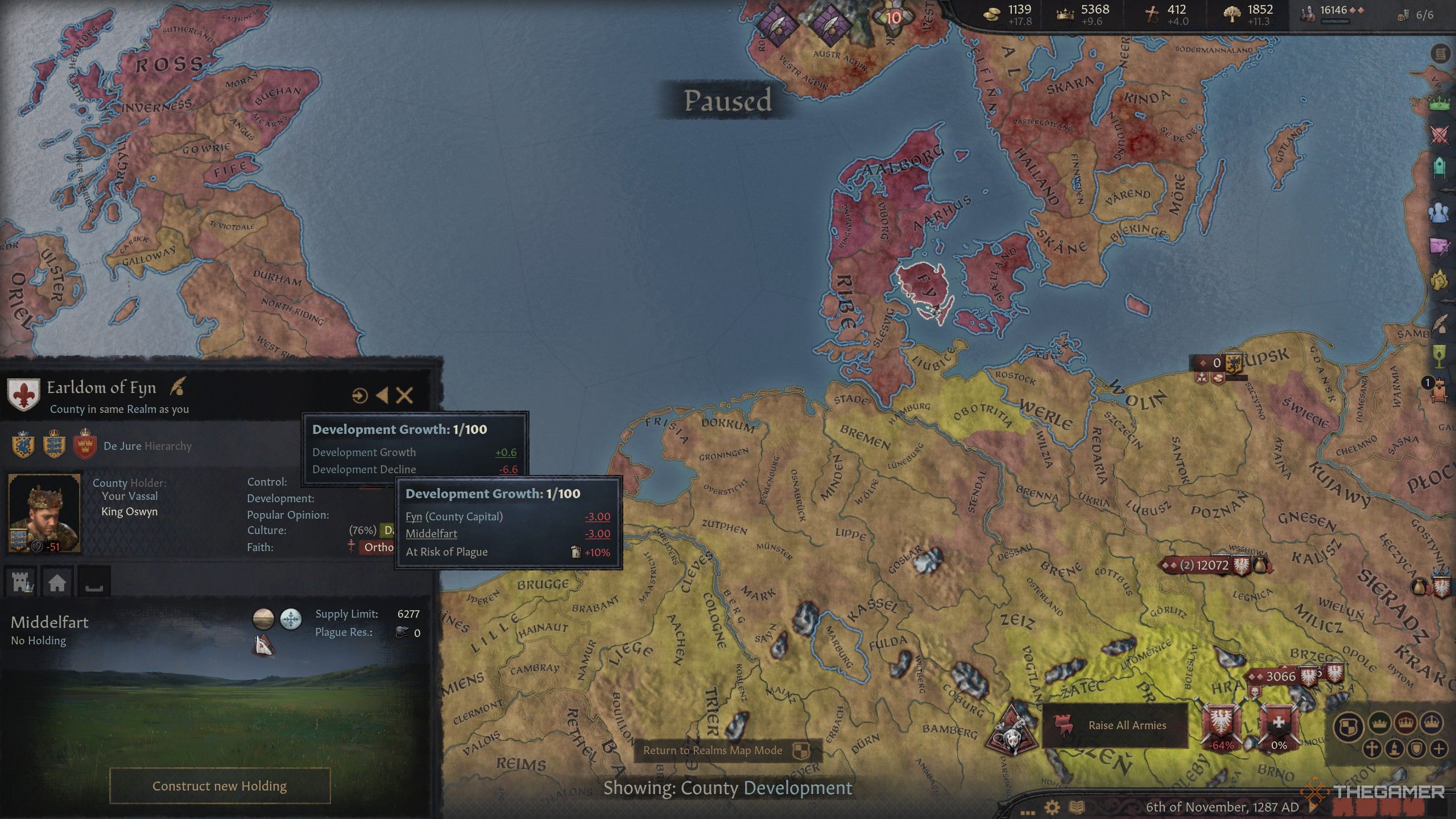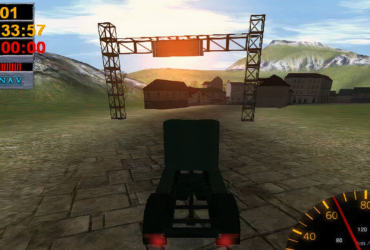There are countless systems at play in Crusader Kings 3 all at once, that it can be hard to wrap your head around all of them. Many of these systems are happening in real-time, from schemes to warfare, but Development happens more casually with direct intervention, which is what makes it harder to understand.

Related
18 Things Beginners Should Do First In Crusader Kings 3
Crusader Kings 3 is an in-depth grand strategy game that’s surprisingly newcomer friendly. These tips will help you understand the basics.
Development is a system that you always want to be investing in, though it’s rarely one you get to impact as directly and quickly as other systems. It’s somewhat complex, but is an almost entirely beneficial system to invest in. Here is everything that Development affects, and how you can maximise it.
What Is Development?
Development is, in the simplest of terms, a quick metric as to how developed a specific county is. This is a number that stretches from 0, all the way up to 100. A county with low Development would be one with few holdings, a small number of people, and is very much still wilderness. This isn’t something that is depicted visually, though it gives you a rough idea of what it represents.
For the most part, Development will increase naturally, though your Innovations, buildings, choices, and other such effects can cause it to both increase and decrease. As a result of Development correlating with the growth of your realm, the highest Development tends to be centered around your realm capital.
This doesn’t mean your capital will always be the most developed county in your realm, just that it gets a bonus to Development growth because it’s your capital.
While Development is increased on a county-by-county basis, it is also tied into how you discover Innovations for your culture. The general growth towards a new Innovation is boosted by the average Development of all counties in your realm of your culture. That means a small Realm with a small culture spread will develop much more quickly than a massive realm with a single culture and lots of varying Development levels.
What Does Development Affect?
Development itself works to increase a lot of systems that operate in the background, which are themselves overall governed by other systems. There are some downsides to high Development as well, though these are trade-offs that are mostly worth the dramatic benefits. Let’s look at both now.
-
Benefits
- Increased Levies
- Increased Taxes
- Increased Supply Limit
- Increased Innovation Discovery Rate
-
Deficits
- Decreased Plague Resistance
- Decreased Success Chance During Hunts
Hunts are a helpful activity when it comes to Prestige gain and some fun events and artefacts, though the slightly reduced chance of success is well worth the bonuses from higher Development. The reduced Plague Resistance is a bigger fear, however, and one that you should work to counter. Building a Hospice in a county to increase its Disease Resistance and having your Personal Physician set to Control Plagues should help balance this out.
How To Increase Development
Now you know what Development is, you should be working to increase it. There are quite a few systems in play here that influence Development Growth, so let’s break them down. There is the actual Development Level, which scales from 0-100, and Development Growth, which starts at 0 and gives you an additional Development Level once it reaches 100.
But how do you increase Development Growth? There are two factors involved in this – raw Development points, and Development percentage multipliers. Development points are the flat number by which your Development Growth increases each month. For example, the Steward Task ‘Increase Development In County’ will add a flat number to the Development Growth scaling off their aptitude, such as one point a month.
This is a very small number though, and would require many years just to gain a single Development Level. This is where the percentage points come in, which are more permanent. Choices you make during certain events, and the buildings you construct within a county add a percentage multiplier to the raw Development Growth. These include Tradeport buildings, Guilds, and so on.
With a Development percentage multiplier of 100% and a raw Development Growth of one every month, you would actually be gaining two whole points every month.
There is a soft cap on the Development Level you can reach in each Era, though this is increased by certain Innovations, bringing the Existing Development Cap all the way up to 90 by the Late Medieval Era. Keep in mind that these bonuses are tied to Culture, and that your Steward must be of the relevant Culture for these Innovations to apply in your realm.
Coastal counties are very conducive to quick Development Growth as they allow you to build both Tradeports and Guilds, letting you very quickly rack up massive percentage multipliers in each Holding that can give multipliers into the hundreds. With a talented Steward and the right Duchy buildings, your Development should be skyrocketing.
Counties also gain a raw point bonus based on the counties surrounding them. If you have a county with only ten Development, and it is beside a county with 20 Development, the lower county will get a 0.1 bonus points each month on the levels between them. In this example, the level 10 county would be getting a whole extra point until it reached level 11, at which point it would be 0.9, and so on.
This bonus is based on the surrounding county with the highest Development Level. There is no additional bonus for a lower level county being surrounded by multiple higher level ones.
Can Development Be Lowered?
You’ve packed your counties with Tradeports and Guilds and you have your Steward working overtime to boost the Development level as high as your current Era allows. All is well, and the taxes are flowing into your treasury and your army has never been so swelled. But now you think to yourself – can your Development be lowered just as easily?
The answer to that is, sadly, yes. The most commonly encountered lowering factor is the Existing Development Penalty. Once you are over your Development Level for the current Era, it will add a negative raw point value decreasing it. If this is higher than the base Development Growth value (without multipliers), then your Development will decrease until it reaches the cap for the Era.
Certain decisions you make and County Control can add negative multipliers as well, though like positive Development Growth, this will have no impact if there isn’t already a raw number decreasing it.
Plagues are the next biggest factor. Because they are more likely to occur and wreak havoc in counties with high Development, they will also destroy that Development Level. While a Plague is active, it will add a raw negative number to the Development Growth, and various modifiers brought by the Plague will increase this even further.
The higher the intensity of the Plague, the higher the negative Development impact. This can be as small as a single point, all the way up to three points every month, and that’s before modifiers. Plagues will devastate your Development, and that is why raising Plague Resistance is so important.
That said, based on the decisions you make and the general impact of a Plague, affected counties will have a Plague Resistance bonus applied after it has passed, and Development will be given asmall boost to help it restore to where it was before.
These are both negative impacts you can work to minimize, though are next to impossible to stop entirely. Overall though, your Development Growth should be much faster than any Plague can bring it down.

Next
Crusader Kings 3: 12 Best Starting Cultures
Not sure which character to pick in Crusader Kings 3? Try someone from one of these Cultures!
Source link












Leave a Reply